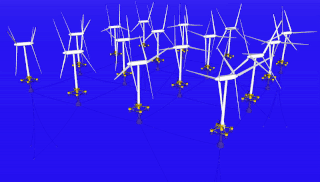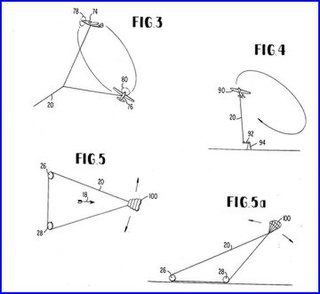
An aircraft is a vehicle that is able to fly by gaining support from the air. It counters the force of gravity by using either static lift or the dynamic lift of an airfoil, or, in a few cases, direct downward thrust from its engines. Common examples of aircraft include airplanes, helicopters, airships, gliders, paramotors, and hot air balloons.

Unpowered aircraft can remain airborne for a significant period of time without onboard propulsion. They can be classified as gliders, lighter-than-air balloons and tethered kites. In the case of kites, lift is obtained by tethering to a fixed or moving object, perhaps another kite, to obtain a flow of wind over the lifting surfaces. In the case of balloons, lift is obtained through inherent buoyancy and the balloon may or may not be tethered. Free balloon flight has little directional control. Gliding aircraft include sailplanes, hang gliders, and paragliders that have full directional control in free flight.

An aerostat is a lighter-than-air aircraft that gains its lift through the use of a buoyant gas. Aerostats include unpowered balloons and powered airships. A balloon may be free-flying or tethered. The average density of the craft is lower than the density of atmospheric air, because its main component is one or more gasbags, a lightweight skin containing a lifting gas to provide buoyancy, to which other components such as a gondola containing equipment or people are attached. Especially with airships, the gasbags are often protected by an outer envelope.

In aeronautics, a balloon is an unpowered aerostat, which remains aloft or floats due to its buoyancy. A balloon may be free, moving with the wind, or tethered to a fixed point. It is distinct from an airship, which is a powered aerostat that can propel itself through the air in a controlled manner.

A hybrid airship is a powered aircraft that obtains some of its lift as a lighter-than-air (LTA) airship and some from aerodynamic lift as a heavier-than-air aerodyne.

The Allsopp Helikite is a type of kite-balloon or kytoon designed by Sandy Allsopp in the UK in 1993. The Helikite comprises a combination of a helium balloon and a kite to form a single, aerodynamically sound, tethered aircraft, that utilizes both wind and helium for its lift.
Airborne wind energy (AWE) is the direct use or generation of wind energy by the use of aerodynamic or aerostatic lift devices. AWE technology is able to harvest high altitude winds, in contrast to wind turbines, which use a rotor mounted on a tower.

Unconventional wind turbines are those that differ significantly from the most common types in use.
Southwest Windpower (SWWP) was a wind turbine manufacturer established in 1987 based in Flagstaff, Arizona, United States. The company specialized in small, reliable battery charging wind generators that complement photovoltaics (solar energy or PV) in supplying energy to rural areas.

A tethered, moored or captiveballoon is a balloon that is restrained by one or more tethers attached to the ground and so it cannot float freely. The base of the tether is wound around the drum of a winch, which may be fixed or mounted on a vehicle, and is used to raise and lower the balloon.

The Tethered Aerostat Radar System (TARS) is an American low-level airborne ground surveillance system that uses aerostats as radar platforms. Similar systems include the EL/M-2083 and JLENS.

Wind-powered vehicles derive their power from sails, kites or rotors and ride on wheels—which may be linked to a wind-powered rotor—or runners. Whether powered by sail, kite or rotor, these vehicles share a common trait: As the vehicle increases in speed, the advancing airfoil encounters an increasing apparent wind at an angle of attack that is increasingly smaller. At the same time, such vehicles are subject to relatively low forward resistance, compared with traditional sailing craft. As a result, such vehicles are often capable of speeds exceeding that of the wind.

A kytoon or kite balloon is a tethered aircraft which obtains some of its lift dynamically as a heavier-than-air kite and the rest aerostatically as a lighter-than-air balloon. The word is a portmanteau of kite and balloon.
Unpowered flight is the ability to stay airborne for a period of time without using any power source. There are several types of unpowered flight. Some have been exploited by nature, others by humankind, and some by both.
Makani Technologies LLC was an Alameda, California-based company that developed airborne wind turbines. Founded in 2006, Makani was acquired by Google in May 2013. In February 2020, Makani was shut down by Alphabet, Google's parent company.
An aerostat is an aircraft that remains aloft through the use of lighter-than-air gases. A narrower and more technical meaning refers only to tethered balloons.

Crosswind kite power is power derived from airborne wind-energy conversion systems or crosswind kite power systems (CWKPS). The kite system is characterized by energy-harvesting parts flying transverse to the direction of the ambient wind, i.e., to crosswind mode; sometimes the entire wing set and tether set is flown in crosswind mode. From toy to power-grid-feeding sizes, these systems may be used as high-altitude wind power (HAWP) devices or low-altitude wind power (LAWP) devices without having to use towers. Flexible wings or rigid wings may be used in the kite system. A tethered wing, flying in crosswind at many times wind speed, harvests wind power from an area that exceeds the wing's total area by many times.
Kitepower is a registered trademark of the Dutch company Enevate B.V. developing mobile airborne wind power systems. Kitepower was founded in 2016 by Johannes Peschel and Roland Schmehl as a university spin-off from the Delft University of Technology’s airborne wind energy research group established by the former astronaut Wubbo Ockels. The company is located in Delft, Netherlands, and currently comprises 18 employees (2018).














